16 - 30 of 223 records
JM-152: Make the punishment fit the crime

Description: Editorial cartoon depicting a congressman proposing that an import duty of a thousand percent be levied on Parisian furniture and works of art, using Ex-Senator Nelson Wilmarth Aldrich as a punchline to talk about the Federal Reserve Act of 1913 that was strongly influenced by the Aldrich–Vreeland Act passed in response to the Knickerbocker Crisis of 1907.
Member of: McCutcheon Editorial Cartoons - ALL (Collection)
Resource Type: Still Image
JM-129: Will It be Conservative or Progressive?
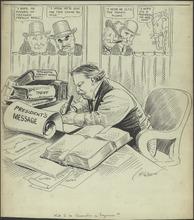
Description: This cartoon depicts President Taft creating a message regarding railroad freight rates. In the 1910, a large portion of goods was transported on railroads in the United States. Railroad owners made large profits by charging rates to ship cargo from one location to another. One of the books in the cartoon is titled, "injunction". This likely refers to the injunction granted by Judge David P. Driver against 25 western railroads located throughout the Midwest to the West Coast, who were all members of the Western Traffic Association. This injunction was granted in Hannibal, Missouri, as a result of an executive order from President Taft. This injunction prevented any of these railroads from raising or adjusting their rates in anyway. The special assistant to the Attorney General, Edwin Grosvenor, presented charges against these railroad companies in St. Louis, Missouri. These charges allegations of price-fixing and conspiracy between these companies to collectively raise rates. President Taft's administration is known for a hard stance against trusts. Taft's predecessor, President Theodore Roosevelt, began this practice during his own administration. Another project begun during President Roosevelt's administration: the construction and governance of the Panama Canal is also shown in this cartoon. (Summary created by Mary Delano, MU History Intern, Spring 2018)
Member of: McCutcheon Editorial Cartoons - ALL (Collection)
Resource Type: Still Image
JM-135: Busy days for the professional stock trader
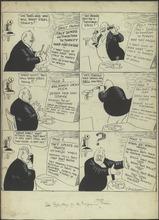
Description: Editorial cartoon depicting a stockbroker trying and failing to predict trends in the stock market.
Member of: McCutcheon Editorial Cartoons - ALL (Collection)
Resource Type: Still Image
JM-185: Tag day

Description: This cartoon depicts two people asking for money. The top panel shows a woman collecting money for the poor and destitute on Tag Day. Tag Day is a day where people will collect money for a charity, and donors will receive a tag showing they donated. The caption for this panel says to remember the children of the poor when being ask the give. The bottom panel shows an officer asking the same man to purchase a liberty loan subscription. These were bonds distributed by the government that were used to support the war effort. In 1917, the United States was a member of the Allied Powers in World War I, which included France, England, Italy, etc. The This panel is captioned, "Don't forget your own children when you are asked to subscribe for Liberty bonds". The man is more skeptical of this purchase than of his donation on Tag Day. (Summary created by Mary Delano, MU History Intern, Spring 2018)
Member of: McCutcheon Editorial Cartoons - ALL (Collection)
Resource Type: Still Image
JM-150: Japanese Haggling
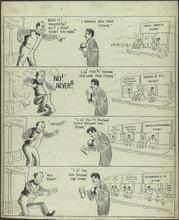
Description: This cartoon depicts a Japanese immigrant attempting to buy property from a white man. As negotiations continue, more Japanese owned stores appear in the background of the the cartoon.Eventually the white man's disposition shifts from enraged to eager as he finally accepts the offer. This cartoon is offering perspective on the relationship between Japanese immigrants and white Americans in the United States, particularly California. The California Alien Land Law of 1913 was passed the same year this cartoon was created.This law prohibited "aliens ineligible for citizenship" from owning agricultural land or possessing long-term leases, but permitted short-term leases lasting up to three years. This law did not have a large tangible impact on Japanese citizens. However, the law remains relevant, because it reflects the discrimination against Japanese immigrants occuring in the 1910s. (Summary created by Mary Delano, MU History Intern, Spring 2018)
Member of: McCutcheon Editorial Cartoons - ALL (Collection)
Resource Type: Still Image
JM-187: Political
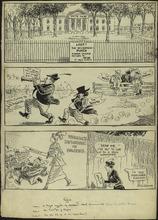
Description: This cartoon depicts various events during the Wilson administration. The top two panels imply a lack of force of the part of President Wilson. After World War I, President Wilson was an outspoken advocate for peace. One of his proposals to accomplish peace was the League of Nations. The League of Nations was an international body, which sought diplomacy and compromise between nations. The United States would never join the League of Nations, because many felt the League would compromise the sovereignty of the United States. The bottom panel of the cartoon shows a woman worrying about meeting the high standards set before her. In 1920, the United States government passed the 19th Amendment, which gave women the right to vote. Women had first found a place in politics by engaging with moral and/or social issues such as education, prohibition, and abolition. By continuing to take a role as protectors of morality women were able to gain enough support to win the right to vote. While the federal government did not allow women to vote in elections until 1920, some states allowed women to vote in state elections. (Summary created by Mary Delano, MU History Intern, Spring 2018)
Member of: McCutcheon Editorial Cartoons - ALL (Collection)
Resource Type: Still Image
JM-138: Well, Gentlemen
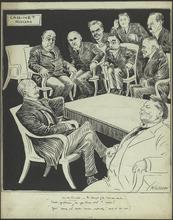
Description: This cartoon depicts Richard Achilles Ballinger, the Secretary of Interior, sweating during a cabinet meeting with President Taft. Ballinger was part of a controversial affair in 1910 that went down in history as either the Pinchot-Ballinger Controversy or the Ballinger Affair. The Ballinger Affair began over an investigation into Clarence Cunningham, who was suspected of illegally transferring land ownership in Alaska to commercial third parties. This investigation began under the Roosevelt administration. Ballinger, the General Land Office Commissioner, eventually concluded the investigation without the approval of his the Secretary of Interior, as he was required. Ballinger left his position for private practice as Cunningham's personal counsel, but he returned to served as Secretary of Interior under President Taft. Ballinger tried to resolve the allegations against Cunningham, but faced great backlash from other members of the administration, including Chief Forester, Gifford Pinchot. Pinchot, among others, accused Ballinger of negligence and endangering public lands. A committee was formed to determine Ballinger's guilt. With the exception of one Republican, all the Republicans on the committee ruled in favor of Ballinger, and all the Democrats on the committee ruled against Ballinger. The Ballinger Affair led to mass criticism of the Taft administration.The dispute between Ballinger and United States Forest Service Chief Gifford Pinchot that contributed to the split of the Republican party before the 1912 presidential election. (Summary created by Mary Delano, MU History Intern, Spring 2018)
Member of: McCutcheon Editorial Cartoons - ALL (Collection)
Resource Type: Still Image
JM-131: Well, I think I am going to have a white Christmas
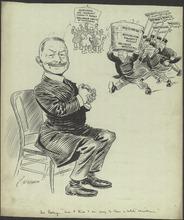
Description: This cartoon depicts Richard Achilles Ballinger, the Secretary of Interior, acting smug over the whitewashed Republican majority report that declares him guiltless while the Democratic insurgent minority report declares him guilty and unfit. Ballinger was part of a controversial affair in 1910 that went down in history as either the Pinchot-Ballinger Controversy or the Ballinger Affair. The Ballinger Affair began over an investigation into Clarence Cunningham, who was suspected of illegally transferring land ownership in Alaska to commercial third parties. This investigation began under the Roosevelt administration. Ballinger, the General Land Office Commissioner, eventually concluded the investigation without the approval of his the Secretary of Interior, as he was required. Ballinger left his position for private practice as Cunningham's personal counsel, but he returned to served as Secretary of Interior under President Taft. Ballinger tried to resolve the allegations against Cunningham, but faced great backlash from other members of the administration, including Chief Forester, Gifford Pinchot. Pinchot, among others, accused Ballinger of negligence and endangering public lands. A committee was formed to determine Ballinger's guilt. With the exception of one Republican, all the Republicans on the committee ruled in favor of Ballinger, and all the Democrats on the committee ruled against Ballinger. The Ballinger Affair led to mass criticism of the Taft administration.The dispute between Ballinger and United States Forest Service Chief Gifford Pinchot that contributed to the split of the Republican party before the 1912 presidential election. (Summary created by Mary Delano, MU History Intern, Spring 2018)
Member of: McCutcheon Editorial Cartoons - ALL (Collection)
Resource Type: Still Image
JM-142: Political methods, old and new
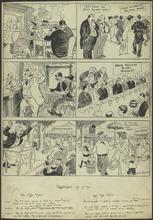
Description: This cartoon illustrates a comparison between "old" and "new" styles of politics in the United States. The men shown in the left panels represent political bosses who sought to influence elections for their own benefit. The people portrayed on the right panels display a more modern approach to politics. This approach included more open and transparent campaigns, and women were allowed to participate in a limited capacity. The political bosses appear confused at this new way of engaging politics. The "old way" of politics shows the bosses holding primary elections only amongst themselves, buying drinks for other men, and consuming excessive amounts of alcohol. The "new way" of politics shows men and women enjoying parties, banquets, and picnics in a family-friendly environment. The political bosses are shocked and confused to see how politics has changed overtime. The shift in politics occurred as women became more involved with political initiatives such as abolition or prohibition. (Summary created by Mary Delano, MU History Intern, Spring 2018)
Member of: McCutcheon Editorial Cartoons - ALL (Collection)
Resource Type: Still Image
JM-189: Compromises
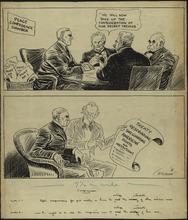
Description: The top panel of this cartoon depicts President Woodrow Wilson meeting with other world leaders at the Paris Peace Conference in 1919. The Paris Peace Conference began after the armistice agreement for World War I, and it eventually produced the Treaty of Versailles. The four men meeting depict the leaders of the "Big Four" Allied powers of WWI. The Big Four nations were the United States, led by President Woodrow Wilson, England, led by Prime Minister David Lloyd, France, led by Prime Minister Georges Clemenceau, and Italy, led by Prime Minister Vittorio Orlando. These men are creating secret treaties, which is in contradiction with Wilson's "14 Points" speech. The first point in this speech is "Open covenants of peace, openly arrived at, after which there shall be no private international understandings of any kind but diplomacy shall proceed always frankly and in the public view". This point was created to address the practice of secret treaties between nations, which many contributed to the beginning of World War I. The 14 points are conspicuously placed in the garbage at this meeting. The bottom panel depicts Uncle Sam showing Woodrow Wilson ways to protect the United States while signing treaties with other nations. This panel is captioned, "he ought to be able to compromise now to satisfy the interests of his own". This caption is used to suggest there may have been conflict between President Wilson's interests and the interests of the United States. (Summary created by Mary Delano, MU History Intern, Spring 2018)
Member of: McCutcheon Editorial Cartoons - ALL (Collection)
Resource Type: Still Image
JM-182: The new income tax
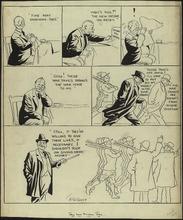
Description: This cartoon depicts a man being irritated with the high income tax rates in the United States. The man suggests the reason for the increased taxes is the fact the the United States is currently fighting in World War I. The man continues to complain about the income tax until he passes a group of soldiers. The man realizes his financial sacrifice is less than that being made by the men serving in the military. (Summary created by Mary Delano, MU History Intern, Spring 2018)
Member of: McCutcheon Editorial Cartoons - ALL (Collection)
Resource Type: Still Image
JM-021: Mr. American reactionary abroad tries to change the opinion of Europe

Description: Editorial cartoon depicting an American visiting places such as France, Germany, and Italy and hearing praise for Roosevelt, which the American does not agree with.
Member of: McCutcheon Editorial Cartoons - ALL (Collection)
Resource Type: Still Image
JM-065: Our present divorce laws
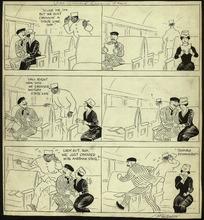
Description: Editorial cartoon depicting a couple being warned by a train worker and moving to sit together or apart depending on what state the train is passing through.
Member of: McCutcheon Editorial Cartoons - ALL (Collection)
Resource Type: Still Image
JM-149: Conundrum of the California Alien Land Law
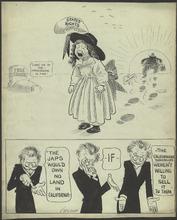
Description: The top panel of this cartoon depicts a little girl, "states' rights" crying over the grave of free silver. "Free silver" refers to the concept of the free coinage of silver, which was a popular idea for public policy among populists and other groups. Those in favor of free coinage of silver would argue that it would increase the circulation of currency, which would make wages higher and loan easier to obtain. Those against the free silver policy typically supported the gold standard, which was officially adopted by the United States in 1879. The gold standard limits the coinage of silver and other currency in circulation, because all currency must defined in the value of gold. Proponents of the gold standard argued it stabilized American currency, which allowed business to function. William Jennings Bryan, an influential American politician and Secretary of State (1913-1915), was an outspoken supporter of the free silver policy. In the top panel, William Jennings Bryan is abandoning states rights to go to California. William Jennings Bryan became involved with attempting to block discriminatory legislation against Japanese immigrants in California, such as the California Alien Land Law. This law placed restrictions of Japanese immigrants' legal ability to acquire and own property. Such discriminatory laws created a tense diplomatic relationship with Japan. As Secretary of State, William Jennings Bryan attempted to limit the impact of such legislation to improve relations between the United States and Japan. The idea behind many of these discriminatory laws in seen in the bottom panel. (Summary created by Mary Delano, MU History Intern, Spring 2018)
Member of: McCutcheon Editorial Cartoons - ALL (Collection)
Resource Type: Still Image
JM-170: Getting scareder and scareder!
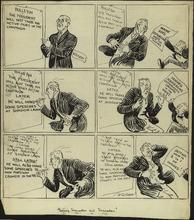
Description: This cartoon depicts President Woodrow Wilson planning his reelection campaign against Charles Evans Hughes during the presidential election of 1916. The first panel shows President Wilson calmly planning to take a passive role in the campaign until he receives a note that the state of Maine voted for Hughes by a narrow majority. The second panel shows a concerned Wilson receiving news that Hughes was addressing crowds in the West, whose vote Wilson was counting on for winning the election. The third panel shows a shocked Wilson learning Hughes was predicted to win the election by a large margin. Despite the assumptions made in this cartoon, Woodrow Wilson would defeat Hughes in the election of 1916, and he became the first democratic president to serve two consecutive terms in a row since Andrew Jackson. Woodrow Wilson appealed to many with his campaign slogan, "He kept us out of war," which appealed to many European (especially German) immigrants who did not wish to have the conflict of loyalty that would come from the United States joining World War I. Despite this, the United States would eventually enter World War I in 1917 during Wilson's second term. The Chicago Tribune published many articles in support of Hughes and his campaign. (Summary created by Mary Delano, MU History Intern, Spring 2018)
Member of: McCutcheon Editorial Cartoons - ALL (Collection)
Resource Type: Still Image
Pagination
- Previous page
- Page 2
- Next page